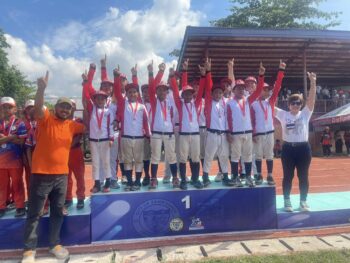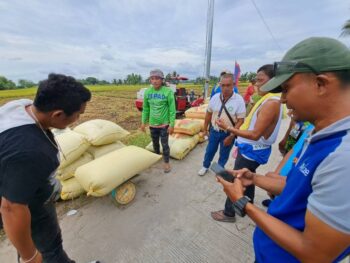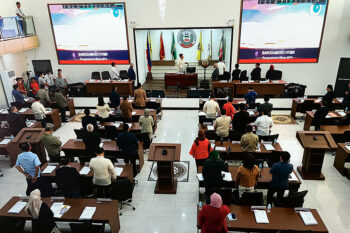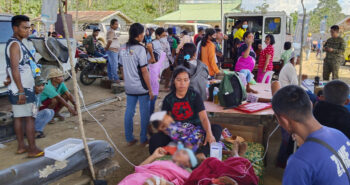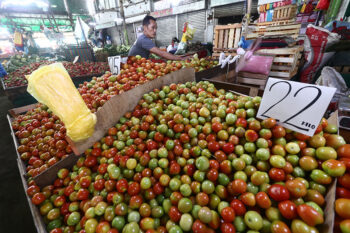
Book: Handumanan (Remembrance): Digging For The Indigenous Wellspring
Author: Karl M. Gaspar, CSsR
Published by the Claretian Communications, Inc. and the Episcopal Commission on Indigenous Peoples, 2021
DAVAO CITY (MindaNews / 02 May) — In the first few pages of this brave and scholarly book “Handumanan” (Remembrance): Digging for the Indigenous Wellspring, Karl Gaspar, CSsR makes a bold assertion. “The first Catholics baptized in what is now the Philippines were Indigenous Peoples (although their descendants now in Cebu are no longer considered IPs).” Through the centuries, a succession of colonial masters, first Spain, and then the United States created colonial government institutions and laws that minoritized the Indigenous Peoples (IPs). They declared IPs who converted to Islam as their enemies like the Moors they fought in Spain and the Native American Geronimo they fought in the United States. As they did so, ordinary Filipinos, converted and baptized, were denied the Spanish language, culture, education, and citizenship, as also American citizenship.
Indeed, Gaspar’s bold assertion may be the first step out of the majority Filipinos’ existential dilemma – since we are not IP, and not Spanish or American, who are Filipinos? Who are our Filipino ancestors? All of these questions this book digs into. Gaspar points out residues of the indigenous belief systems (IBS) remain deeply imbedded in the Filipino psyche, as I also note certain practices like: altars abound everywhere in homes and motor vehicles, on land and on sea; being with dead ancestors in the cemeteries on All Souls day and night.
Gaspar hopes that the Filipinos remember (whether the COVID virus is a memory or still persisting by the time the book is published in 2021 and Filipinos might still find it relevant to meaningfully commemorate the 500th year anniversary of the Spanish colonization-evangelization experience in the Philippines). A religious of a Roman Catholic congregation, Gaspar hopes lessons are learned, and makes a contribution (not to forget) that our remaining ancestor IPs live in the Philippine uplands. Eight out of 10 Filipinos are baptized Roman Catholics despite the inroads of the Protestant churches. Those who never converted are the Moro people (mostly in Mindanao) and the IPs who together constitute 10 to 20% of the Filipino population approaching 103 million in 2018. An estimated 14-17 million are spread out in 110 ethno-linguistic groups in Luzon and the Cordillera Administrative Region (33%), Mindanao (61%), and the rest in the Visayas. Now pushed to live in the highlands, it was not always so. Agnes Miclat Cacayan in her own review of the Handumanan said the IPs were not just mountain dwellers but also lowlanders and seafarers. She adds, there is much to be proud of in the ways of ancestor IPs like win-win governance, the privileging of women in religious (Babaylan) as well as leadership roles.
Note that Gaspar says “our ancestors IPs.” This is a brave book not only because Gaspar is a part of a congregation of the Catholic church that by Papal Bull or a public decree by Pope Alexander VI (who was the Spanish Rodrigo Borgia) in 1493 authorized the colonization and conversion mission of Spain and Portugal. In 1494, the kings of these countries signed the Treaty of Tordesillas – all lands eastward to Portugal, and all lands westward to Spain. In this book, Gaspar clearly speaks on the IP’s behalf, as he hopes the Catholic church does, as it did in Vatican II (1962 – 1965) “when proselytization gave way to a missionary enterprise that embraced the thrust of total human development.”
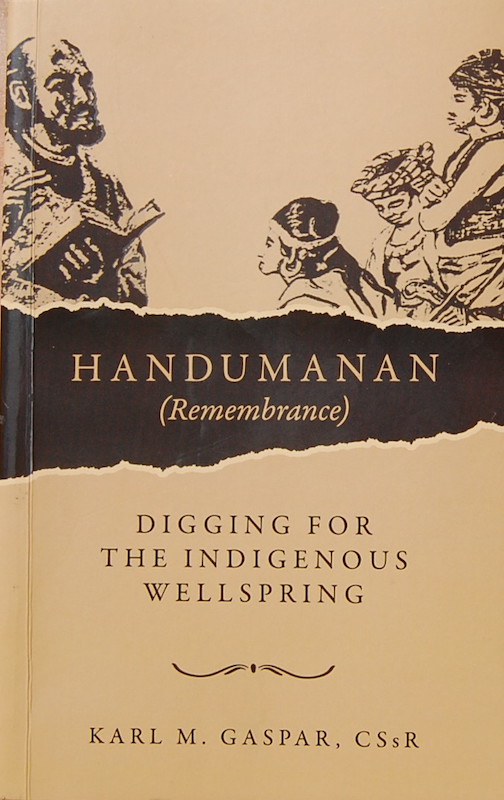 The Mindanao-Sulu Pastoral Council (MSPC) gave special attention to the plight of the IPs. At this time Gaspar was actively involved in the programs of the church and the MSPC. We also note that Pope John Paul II, in a televised address from the Vatican on 12 March 2000, dressed in the purple robes of Lent confessed “mea culpa.” We forgive and seek forgiveness for church violence committed in the treatment of heretics during the crusades; in the church inquisition; and in the forced conversion of indigenous peoples (IPs). But there is more talk than walk in the church response to the situation of the remaining IPs, Gaspar reminds.
The Mindanao-Sulu Pastoral Council (MSPC) gave special attention to the plight of the IPs. At this time Gaspar was actively involved in the programs of the church and the MSPC. We also note that Pope John Paul II, in a televised address from the Vatican on 12 March 2000, dressed in the purple robes of Lent confessed “mea culpa.” We forgive and seek forgiveness for church violence committed in the treatment of heretics during the crusades; in the church inquisition; and in the forced conversion of indigenous peoples (IPs). But there is more talk than walk in the church response to the situation of the remaining IPs, Gaspar reminds.
It is not only that our ancestor IPs were minoritized by colonial governments, the baptized were kept ignorant about the Reformation movement within the Catholic churches of Western Europe in the 16th century. This movement aimed to bring the church back to its early Christian moorings, as in the time of St. Francis of Assisi (1182 – 1226), centuries before. But the seeds of Reformation never got to the colonies, and it is crucial that the baptized know why this was so. Even more than minoritization, colonialism ensured loss of our ancestral memory that includes Christianity. The resulting commercial successes of colonial ventures to the Americas and Asia perhaps temporarily put on hold the prophetic voices silenced by the dreaded Inquisition within the church.
Meanwhile, miseducation of Filipinos continues. Historian John Hale in Age of Exploration said that in fact these lands in the Americas and Asia were known to its inhabitants who possessed larger territories and higher levels of civilization. The great traditions of Hinduism, Buddhism and Islam (as shown by artifacts) were already part of the inheritance of IPs in Asia, and in the Philippines before the 16th century.
IPs and colonizers
Central to the remembering of the last five hundred years is a Portuguese nobleman by the name of Fernando de Magalhaes, more popularly known as Ferdinand Magellan, who is the key figure in the initial colonial conquest in the Philippines, which the church reckons was 1521.
In The Triumph of Moro Diplomacy: The Maguindano Sultanate in the 17th Century by Ruurdje Laarhoven it is told that Magellan was in the Visayan island of Bohol, one decade before. In 1511, the Portuguese encroachment upon Africa and Asia culminated in the conquest of Malacca, a century-old kingdom that had developed into a prosperous trading port and a hub for Islamic scholars. (The resulting dislocation directly led to the spread of Islamic scholars across the rest of Southeast Asia. A member of the Malaccan royal house Sharief Kabungsuan arrived in Central Mindanao, and in the next few years converted one of two datus to Islam.)
In that same year 1511, the Anthony Abreuws expedition left Malacca and crossed the Celebes sea on three ships. One under the command of Francisco Serrao went directly to the Moluccas spice islands, and in the coming years took advantage of a conflict between the chiefs of Tidore and Ternate and established the dominance of the Portuguese crown in Ternate. Two other ships ventured farther North to the Visayan Islands. In the following years, Serrao sent letters and reports back to Portugal. Among these was a letter to his friend Magellan, who was part of the Abreuws expedition, encouraging him to return to Ternate. But discouraged by humble pickings he received from the Portuguese crown for the expeditions to Africa and the East, Magellan went to Spanish King Carlos I instead and declared he could obtain the spices (monopolized by the Portuguese) by sailing westward through an isthmus in Argentine South America (now called strait of Magellan) that provided a water passage from the Atlantic to the Pacific ocean. Magellan had this route mapped out in his head and talked about it to the Spanish officers. Magellan had his eyes on the gold which you could take with you, unlike spices that needed to be brought to Europe to be sold, with most profits going to the crown.
In Ani: The Life and Art of Hermogena Lungay by Marjorie Evasco, there is the story of two causeways that connected the islands of Panglao (now a foremost tourist attraction) to Tagbilaran, the capital of Bohol. “The causeways are like arms that enfold sites memorable to Boholanos: the shore of the channel between Tagbilaran and Panglao where the rich kingdom of Dapitan was once built on stilts..Ruled by the brothers Dailisan and Pagbuaya, it was burned to ashes in the 16thcentury.” Datu Dailisan was killed in battle. The surviving chief Pagbuaya led the survivors out of Bohol and sailed towards Northern Mindanao, in a land they also called “Dapitan” (where centuries later the writer and national hero Jose Rizal was exiled before being put to death by the Spanish colonial government.) The plunder of ancient Dapitan was the first Portuguese colonial conquest in the islands that was called “Felipinas” (in honor of King Felipe II) by the Legazpi expedition, sixty years later. The Papal Bull of Pope Alexander VI (who was the Spanish Rodrigo Borgia) authorizing the colonization and conversion mission to Portugal and Spain had far-ranging negative causes and effects.
In Chapter III Gaspar looks into the Trajectory of the Colonizers’ Early Contacts, The Spanish colonial expedition was directed by King Carlos I to pursue a direct course to the spice-rich Moluccas. It reached Leyte on 16 March 1521 after a one and one half years perilous crossing across the Pacific having left Seville 20 September 1519. Instead of proceeding directly to the Moluccas, Magellan tarried. After a mass celebrated in one of the Visayan islands, he tarried some more and went around other Visayan islands, until he finally reached Cebu. He then instructed the priest Fr. Valderrama to baptize the people. Gaspar narrates that even before Magellan had formally met and discussed things with the Cebu chief Datu Humabon, arrangements were made for baptizing him and his people that Saturday, to take place the following day 14 April. This was meant to bind them as loyal subjects of the Emperor by papal authority. They had been feted by the Cebu chief Datu Humabon with coconut wine, food and music played on gongs by bare breasted young girls wearing palm cloth down to their knees. In Lawrence Bergreen Over the Edge of the World, Datu Humabon in his palace is described as wearing an embroidered scarf around his head, his body tattooed with various designs, and around his neck, precious gems and large earrings of gold that glistened in Magellan’s eyes. He had found what he was looking for. In 1511, the Portuguese army was in Bohol and had sacked and burned to the ground the ancient kingdom of Dapitan. Magellan found gold there. Laden with war booty, he quickly set sail back to the Moluccas by crossing the Bohol straight to Northern Mindanao, and sailing down south to the Sarangani Bay, sailed farther down to the Moluccas. Looking at Datu Humabon during the festivities, Magellan was certain there was more gold, perhaps a gold mine somewhere in Cebu that was next to the island of Bohol and Mactan. Magellan soon started to foment conflict between the chieftains of Cebu and the resistant chief of Mactan. But perhaps finding people were getting angrier, and eager to look for the gold, he decided impulsively to cross to Mactan. The next day he commanded the people “Burn your idols”. Magellan met his own death at the hands of the IP Mactan Datu Lapu-lapu and the angry native inhabitants.
With the death of Magellan, whatever was left of the 124 (from the 264 original crew) in two out of five ships, the creaky Concepcion and the Victoria commanded by Sebastian del Cano, hurriedly left on 1 May. They made it to the other spice island Tidore on 8 November 1521. They had made a wrong turn, got lost among the other Visayan Panay islands, but finally found the Bohol strait. Upon arriving in Tidore, they scuttled the Concepcion, filled the Victoria with cloves and other spices. Magellan and his crew found gold in the ancestral gravesites of the Visayan islands. How else could Sebastian del Cano have paid for the cloves and other spices to fill up the Victoria? They sailed back to Spain entering the bay of San Lucar, Spain on 6 September 1522 with 18 surviving crew members (unaware they had circumnavigated the world). The precious cargo was soon declared a commercial success by King Carlos I. And success it was, for soon three other failed expeditions returned to the area. It was on the fourth expedition led by Miguel Lopez de Legazpi that Cebu was captured in 1568, and in waves of attacks, Manila in 1571.
In the Southeast section of The Illustrated History of Art by David Piper, we visually see the reverence for ancestors of the IPs of the Southeast Asian countries of Indonesia, Malaysia, Philippines. This reverence is expressed in many forms: megaliths, permanent galleries of wooden figures looking out at ricefields, wooden carved standing or squatting figures embodying ancestor spirits, as also carved decorations in houses and textiles. Gaspar cites that in Cebu “it was not long before the colonizers started to assert their superiority over the IPs,” relied on them to provide food when they themselves showed no interest in tilling the land, and “lusted after whatever gold was owned by the natives and robbed these from them…even desecrating the graveyards…stole gold, jewels and valuables that the bereaved had placed with the dead,” and sourced them sourced them elsewhere around the other Visayan islands, Panay, Negros and Leyte.
The initial contact between the IPs and Colonizers struck at the very heart of the IBS of ancestral IPs: respect for ancestors and ancestral gravesites. Perhaps it is just as well, that the Catholic Church had missed commemorating the Magellan colonial conquest in 1511 in Bohol (1568 in Cebu / 1571 in Manila) by a decade and should have happened in 2010.
Remembering our ancestors
This latest book by Karl Gaspar, CSsR is a scholarly work (59 pages of endnotes and references), diligently interwoven, and made easy to understand by his manner of story telling historical facts, and by presenting the pre-colonial IBS of the IPs in tables and matrices to visually summarize findings. Gaspar follows a thread based on the writer’s witness and point of view who regards the IPs as “our ancestors.” From such a standpoint, the IP stories told are more than snap shots, but a product of a writer’s discerning witness and reflection that guides the readers’ remembering of our ancestors.
In Chapter II, Gaspar collected and collated data to show our ancestors’ way of life and Indigenous Belief System as they were encountered by the colonizers. Gaspar lived in still extant IP communities and witnessed the IBS interwoven into the everyday material and spiritual life with reverence for a Supreme Deity and ancestors and nature spirits (which he details in various other books like Manobo Dreams of Arakan: A People’s Struggle to Keep their Homeland, in 2011, and The Masses are Messiah: Contemplating the Filipino Soul in 2010).
There is much for the Filipino to learn from the ancestral IBS and lifeways, and Gaspar explains all this using very understandable and simple terms. He provides a summarized table of the names of I) Gods/Goddesses (God was male and female) and how the earth was created. II) Types of ritual by ethno-linguistic groups, manner and symbols used. III) Integral elements of the IBS of the IPs namely: Belief in the Supreme deity and the spirit world (a monotheistic concept elevating the deity who is distant and removed unlike the ancestral spirits and nature spirits who enter into people’s lives; Afterlife and no concept of hell and sin, with ethics determined by societal immanence not by transcendent principles; Concern for good health, prosperity and well being – rituals, deities and spirits are invoked in this-wordly concerns; Fear of spirits and death with a deep reverence for ancestors both living and dead, and a deep respect for burial grounds, with elaborate rituals for the dead’s immortality; and the Shaman (Babaylan, Catalonan, Baylan) as the medium and healer, mostly women , also transvestites, who took on this office and presided over rituals.
In chapter IV, Gaspar presents historical data on what took place during the Spanish colonization period. The colonial undertaking entered into by the monarch of Spain with the Catholic Church had justified the monarch’s possession of a just title Patronato Real to the lands colonized by them, by virtue of the undertaking with the Papacy to see to its evangelization. Thus in colonial expeditions, friars were on board, in the Legazpi expedition, Fr. Urdaneta and four other Augustinians, tasked to lay the foundations of the Catholic church . In the early periods, the friars were valuable links to the Spanish monarchy. But this dominant role was rapidly eroded with the passing of the centuries and conflicts between the lay colonizers and the regular clergy emerged, the root cause being that the colonizing soldiers were penniless, and continued “digging for gold” in the ancestral graveyards” collecting tributes and exacting forced labor among the converted to build fortresses of protection (including churches and convents). In such a situation, the IPs who were baptized were shunted here and there in various political and social organizational experiments like the encomienda with souls entrusted to an encomendero, and to ensure that the Spanish lay officials and friars were close to sources of food, services, livelihood of the baptized, reduccions were established and bigger settlements of pueblos that incorporated native elites.
A model of Catholicism evolved out of this encounter of the IBS with the friar’s brand of Christianity, what Gaspar termed as “this-worldly orientation of Philippine religiosity or the non-transcendent kind that characterized the indigenous religion.”. Two hundred revolts are recorded through the centuries against abuses and injustices. In time, a nationalist movement (including a clamor for equality between the Spanish regular orders and the secular Filipino priests that who had taken over the parishes that had increased in number.) All these protests related to colonial abuses, and abuse of women, eventually led to the Philippine Revolution of 1896 that, apart from economic-political realities, was also occasioned by cultural-religious elements.
Native response to 333 years of Spanish colonial rule ranged from accommodation to resistance, the resistance by the Babaylan Tamblot in 1624, and the longest lasting rebellion led by Dagohoy also in Bohol that lasted almost one century (1744-1829). Thus in Bohol we find, churches built on top of earlier church ruins. The churches were colonial fortresses and first to be burned. The Philippine Revolution of 1896 that led to the declaration of independence from Spain, and the inauguration of the Philippine republic was upended by a bogus Battle of the Manila Bay – a naval war invented by the Spanish and the United States, but was only a prelude to the signing of a treaty in Paris where Spain ceded the Philippines to the United States for $20 million, and in this way the United States secured legal ownership of 90% of the total land area, and later denied ancestral domains to the IPs and Moros. The United States colonial government proceeded to pass land registration laws, establish free trade detrimental to the development of a Filipino economy, that kept the country under a continuing neo-colonial status. After dragging the Philippines into the Second World War that brought destruction to all cities and livelihood, and death to a million Filipinos, the United States granted the Philippines independence in 1946.
In the face of the COVID pandemic and climate change, is there something to be learned from the IBS of the indigenous people? Is there something that the church can do to support the extant IP and nurture them?
Here is Brother Karl telling it like it is, in the last chapter of the book. Since the 1990s the IPs, called Lumad in Mindanao, received scarce church support when compared to the years of Vatican II. The MSPC that gave special attention to the IP struggle has received no support from the bishops since it pulled out of the Board that oversaw the work of the secretariat. Like the Catholic Bishops Conference of the Philippines, the Association of Major Religious Superiors popularized religious paradigms but not much more. The reduced concern for IP issues and people’s rights arose from a red scare at the tail end of the Marcos regime, and continues to the present time.
In the time of Pope Francis and Laudate Si, Gaspar reposes hope that the indigenous belief systems make a contribution to counteract climate change and safeguard the Earth, but this needs to be supported by the faith community and the local churches by giving priority to the IP ministry. There have been less missionaries working for the Lumad communities compared to 1970s-1980s. Gaspar points out, as a last word “Empowering vulnerable groups of people to resist violent domination and oppressions means bringing together the roots of the IBS and the values of the first Christian communities in the resurrection epoch of Jesus Christ.”
No serious historian and literary writer should be without this stirringly truthful and well-researched book Handumanan – indigenous wellspring of Filipino heritage.
[Maria Virginia Yap Morales describes herself in the times of COVID as a gardener, keeper of a house she built in her hometown Davao in 1996 knowing her two children were already financially able to support themselves in Manila, practitioner of meditation and yoga, and a writer. She first came home in late 1978-1985, co-founding some micro media, women organization and Kulturang Atin with Karl Gaspar. She has written three books – ‘Diary of the War: WW II Memoirs of Lt. Col. Anastaco Campo’ (2006), ‘Balay Ukit: Tropical Architecture in pre-WWII Filipino Houses’ (2013) and ‘Ascending the Fourth Mountain: A Personal Account of the Marcos Years’ (2021)]


